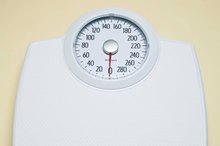Causes of Sagging Breasts in Teenagers and Young Women
Like women, breasts come in a variety of beautiful shapes and sizes. Teens and young women usually enjoy "perky" breasts — meaning they're full, firm and don't sag.
That said, there are reasons why even a young woman's breasts might droop to some extent. If your breasts look a bit saggy to you (or you have a teenage girl in your life who does), don't fret.
Simple things like a well-fitted bra can often help you get the look you want for your breasts. Or you can choose to embrace your body just the way it is.
Read more: How to Conquer Your Biggest Body Insecurities
Breast Anatomy and Variation
Before getting into causes of saggy breasts, it helps to first understand normal breast anatomy and variation.
Your breasts consist primarily of milk-producing glands, milk ducts that carry milk to the nipples, fatty tissue, supporting ligaments and other connective tissue as well as the overlying skin. In young women, the nipples usually point straight ahead rather than downward.
But your breast shape and size depend on the genes you inherit from your parents, as well as your body weight, hormone levels, pregnancy history, age and other factors. As such, normal breast shape and size vary from one woman to another and typically change as you age.
- Before getting into causes of saggy breasts, it helps to first understand normal breast anatomy and variation.
- As such, normal breast shape and size vary from one woman to another and typically change as you age.
3 Possible Causes of Sagging Breasts
1. Breast Size
Foods & Supplements That Help Dense Breast Tissue
Learn More
Breast size commonly contributes to breast sagginess in teens and young women. Larger breasts are generally more likely to sag than smaller breasts due to their greater volume and weight.
If you have relatively large breasts, you might notice that the part below your nipple rests against your chest wall when you're braless. You might interpret this as sagginess (breast ptosis in medical lingo). This usually doesn't represent an abnormality but rather normal variation. You do you, girl!
Rarely, teenage girls experience rapid and continued breast growth that results in very large breasts for their frame, potentially leading to neck, shoulder and/or upper back pain with breast droopiness, as reviewed in a February 2013 Seminars in Plastic Surgery article 1. This uncommon condition is known medically as juvenile or virginal breast hypertrophy.
- Breast size commonly contributes to breast sagginess in teens and young women.
2. Weight Changes
All women's breasts contain some fat (adipose tissue). If you gain a significant amount of weight, your breasts often get larger primarily due to an increase in fatty tissue and might sag a bit.
Conversely, if you lose a lot of weight, your breasts might decrease in size due to a decrease in the volume of breast fat. If the decrease in breast size is substantial, your breasts might sag due to both reduced volume and excess breast skin.
- All women's breasts contain some fat (adipose tissue.
- If you gain a significant amount of weight, your breasts often get larger primarily due to an increase in fatty tissue and might sag a bit.
3. Pregnancy
Why Are My Breasts Sagging at 22?
Learn More
Pregnancy causes breast enlargement, often an increase of several bra cup sizes. This occurs due to growth of the milk-producing tissues and milk ducts as your body prepares for breastfeeding. Your breasts gradually return to their pre-pregnancy size after you stop breastfeeding or shortly after delivery if you opt for formula feeding.
When your breasts return to their usual size, they might appear droopier than before you got pregnant — even in teens and young women. In general, the larger your breasts were initially, the more likely you'll notice some sagginess after pregnancy. The likelihood of developing breast drooping also increases with each subsequent pregnancy.
Contrary to popular belief, breastfeeding itself does not increase your risk for developing breast sagging, as reported by researchers in the September-October 2008 issue of the Aesthetic Surgery Journal 56.
- Pregnancy causes breast enlargement, often an increase of several bra cup sizes.
- Your breasts gradually return to their pre-pregnancy size after you stop breastfeeding or shortly after delivery if you opt for formula feeding.
- Breast size commonly contributes to breast sagginess in teens and young women.
- If you gain a significant amount of weight, your breasts often get larger primarily due to an increase in fatty tissue and might sag a bit.
Can You Prevent Droopy Boobs?
Eating a nutritious diet that maintains your body weight in healthy range can help prevent breast sagging due to excess fat. Also avoid smoking, which is a risk factor for breast ptosis, as reported in the May 2010 issue of the Annals of Plastic Surgery 1.
A supportive bra is helpful, particularly for women with larger breasts and those who participate in sports or activities that bounce "the girls" around. In general, limiting the amount of time you go braless (other than when you're sleeping) might also help prevent breast sagging over time due to the effects of gravity and aging.
What to Do About Saggy Breasts
Breast sagginess typically poses no threat to your overall health outside of possible upper back, neck and/or shoulder pain due to very large breasts. Breast reduction surgery is a potential treatment for this condition. Aesthetic surgeons, however, are understandably cautious about performing permanent body-altering procedures on young women still in their teens.
Many women find a high-quality, supportive bra counters the appearance of mild breast sagginess. If the appearance of your breasts negatively affects your body image, confidence or self-esteem, aesthetic surgery might be an option 5.
The two most common procedures used to address breast ptosis are a breast lift (mastopexy) or breast implants (breast augmentation surgery). In some women, a combination of these procedures leads to the best outcome.
Talk with well-qualified plastic surgeon if you're considering an aesthetic breast procedure to correct sagginess. Ask questions about the potential risks and the expected short- and long-term outcomes, including scarring and discomfort. Also keep in mind that health insurance generally does not cover these procedures if done solely for cosmetic reasons.
Read more: 7 Celebs Who Fiercely Defended Their Plastic Surgeries
- Breast sagginess typically poses no threat to your overall health outside of possible upper back, neck and/or shoulder pain due to very large breasts.
- Talk with well-qualified plastic surgeon if you're considering an aesthetic breast procedure to correct sagginess.
Related Articles
References
- Annals of Plastic Surgery: Breast Ptosis -- Causes and Cure
- Seminars in Plastic Surgery: Hyperplastic Breast Anomalies in the Female Adolescent Breast
- Breast Cancer Research: Height, Adiposity and Body Fat Distribution and Breast Density in Young Women
- Aesthetic Surgery Journal: The Effect of Breastfeeding on Breast Aesthetics
- The Journal of Breast Health: Virginal Breast Hypertrophy and Symptomatic Treatment: A Case Report
- Winocour S, Lemaine V. Hypoplastic Breast Anomalies in the Female Adolescent Breast. Semin Plast Surg. 2013;27(1):42–48. doi:10.1055/s-0033-1343996
- Cruz NI. Breast Asymmetry in Women Requesting Plastic Surgery of the Breast. P R Health Sci J. 2018;37(4):230‐238.
- Chen JH, Chan S, Yeh DC, Fwu PT, Lin M, Su MY. Response of bilateral breasts to the endogenous hormonal fluctuation in a menstrual cycle evaluated using 3D MRI. Magn Reson Imaging. 2013;31(4):538-44. doi:10.1016/j.mri.2012.10.022
- Kader T, Hill P, Rakha EA, Campbell IG, Gorringe KL. Atypical ductal hyperplasia: update on diagnosis, management, and molecular landscape. Breast Cancer Res. 2018;20(1):39. doi:10.1186/s13058-018-0967-1
- Hisham A. Juvenile Breast Hypertrophy: A Successful Breast Reduction of 14.9% Body Weight without Recurrence in a 5-Year Follow-Up. Case Rep Surg. Volume 2017, Article ID 3491012. doi:10.1155/2017/3491012
- Kayar R, Çilengiroğlu ÖV. Breast Volume Asymmetry Value, Ratio, and Cancer Risk. Breast Cancer (Auckl). 2015;9:87-92. doi:10.4137/BCBCR.S32789
- Reilley Ann F. Breast Asymmetry: Classification and Management. Aesthetic Surg J. 2006;26(5):596-600. doi:10.1016/j.asj.2006.07.006
- Cruz NI. Breast Asymmetry in Women Requesting Plastic Surgery of the Breast. PR Health Sci J. 2018 Dec;37(4):230-238.
Writer Bio
Dr. Tina M. St. John owns and operates a health communications and consulting firm. She is also an accomplished medical writer and editor, and was formerly a senior medical officer with the U.S. Centers for Disease Control and Prevention. St. John holds an M.D. from Emory University School of Medicine.









